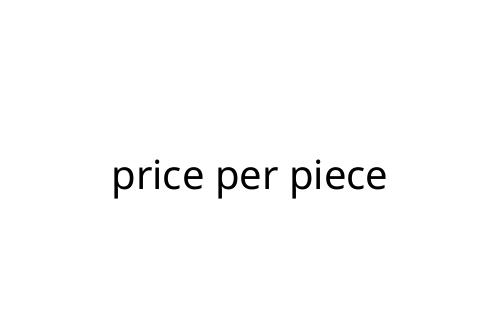price per piece
When you’re shopping around—whether it’s for groceries, office supplies, or even clothing—you’ll often see the term “price per piece.” It’s one of those simple metrics that can offer real clarity, letting you quickly compare the actual cost of what you’re buying. But what does price per piece really mean, and how can you use it to your advantage as a smart shopper or business owner?
What Does “Price Per Piece” Mean?
Price per piece is straightforward: it’s the cost divided by the number of individual items you get. Say you’re buying a pack of 10 pens for $5. That’s 50 cents per pen. This number strips away marketing gimmicks, letting you measure value side by side, regardless of packaging or bundle size.
Why Bother Calculating It?
The biggest value of price per piece is in comparison. Unit pricing cuts through the confusion created by bulk deals or multi-packs. For example, you might see apples sold at $4 for a bag of eight, while another store sells them loose at $0.60 each. Which is cheaper? A quick calculation shows the bag comes out to $0.50 per apple—so the bag is the better buy.
For businesses, knowing the price per piece is equally essential. It helps with setting retail prices, controlling margins, and making informed sourcing decisions.
How to Calculate It
The math behind price per piece is basic:
- Price per Piece = Total Price ÷ Number of Pieces
Whether it's socks, screws, or soda cans, this calculation works across the board.
Example:
A box of 24 light bulbs costs $18.
$18 ÷ 24 = $0.75 per bulb.
Not every store posts this number, so don’t be afraid to pull out your phone’s calculator.
Pros: Why It’s Useful
- Smarter Shopping: Patterns become obvious—sometimes, bulk doesn’t mean cheaper.
- Budget Control: Know exactly what each item costs.
- Transparency: Avoid being misled by fancy packaging or bonus offers.
- Business Planning: Great for inventory management and price setting.
Cons: Limitations & Caveats
- Not Always Apples-to-Apples: Quality may vary across packs, so don’t let a low price per piece blind you.
- Hidden Extras: Some packs have special features, bonus sizes, or differences that affect the actual value.
- Waste Potential: Buying bigger for better price per piece only works if you’ll use it all.
Tips for Using Price Per Piece
- Always check the unit size—sometimes, packages look alike but don’t contain the same number of items.
- Factor in quality and actual need—don’t just chase the lowest price.
- For perishables, only buy in bulk if you can use everything before it expires.
Final Thoughts
Price per piece is a practical tool for making smart buying decisions. It cuts through the marketing noise and gives you a clear way to compare costs and value. Whether you’re shopping for yourself or for your business, a quick calculation of price per piece can help you get more for your money—no guesswork needed.


 Henry Stevenson
Content Strategist
Henry Stevenson is the Content Strategist at Jackpot Lucky Deal, bringing a rich background in gaming journalism and an eye for detail to every article and update. Henry’s primary focus is on delivering engaging, insightful content that helps readers understand the nuances of jackpot games, from slot machine strategies to tips on maximizing wins with responsible betting. Known for his ability to simplify complex topics and make them accessible, Henry has a knack for curating content that resonates with jackpot enthusiasts and newcomers alike. His role involves not only keeping readers informed about the latest news and trends but also crafting guides that support smarter, more informed gameplay. Through his work at Jackpot Lucky Deal, Henry aims to help players optimize their chances of winning while staying educated on safe betting practices.
Henry Stevenson
Content Strategist
Henry Stevenson is the Content Strategist at Jackpot Lucky Deal, bringing a rich background in gaming journalism and an eye for detail to every article and update. Henry’s primary focus is on delivering engaging, insightful content that helps readers understand the nuances of jackpot games, from slot machine strategies to tips on maximizing wins with responsible betting. Known for his ability to simplify complex topics and make them accessible, Henry has a knack for curating content that resonates with jackpot enthusiasts and newcomers alike. His role involves not only keeping readers informed about the latest news and trends but also crafting guides that support smarter, more informed gameplay. Through his work at Jackpot Lucky Deal, Henry aims to help players optimize their chances of winning while staying educated on safe betting practices.

